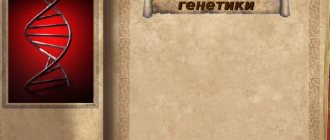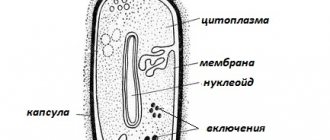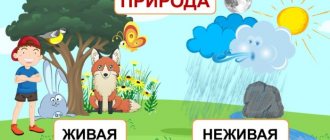Variability
Variability is the property of organisms to acquire new characteristics that differ from their parents. If these characteristics are fixed in subsequent generations, then they speak of hereditary variability.
Rice. 1. Modification variability.
Variability determines the variety of properties and external data within one species.
Gene
The material carrier of information about the properties of a cell is DNA. It is part of chromosomes - structures of the cell nucleus that store hereditary information.
TOP 4 articles that are read along with this
- 1. Mutational variability
- 2. Basic methods of plant breeding
- 3. Methods for studying human genetics
- 4. Modification variability and its significance in the life of an organism
According to modern views of heredity, differences between species and organisms within a species are determined by differences in the proteins from which the organisms are built.
Information about the structure of a particular protein is contained in the gene. A gene is a section of a DNA molecule.
Rice. 2. Gen.
Information is read from genes, which is then implemented in the creation of protein molecules.
Topics of projects and research papers in music
Topics of projects and research papers in musicIn this list, school students are provided with the most interesting ones for researchmusic project topics
.
These research paper topics in music
involve schoolchildren conducting research on choral songs, symphonies, operettas, as well as instrumental music, musical instruments of various nationalities and the history of their origin.
Among the topics presented below, you can choose the topic of project work on music
for any school grade (primary grades, 5th grade, 6th grade, 7th grade, etc.).
Alexandra Pakhmutova. Creative path.
"Seasons". P.I. Chaikovsky. “Children's Album” by P.I. Tchaikovsky. Musical games for boys and girls. “The One Beautiful Priests” (musical by Pushkinian A. S. Dargomyzhsky). “She always walks on the sunny side of the street” (about the life and work of Mireille Mathieu). “Poem in memory of S. Yesenin” as one of the greatest works of G.V. Sviridova. “I’m glad to scramble about my domras.” History of domra: past, present and future. “Electronic Muse”, dedicated to the work of A.P. Borodin. “Queen of Spades” P.I. Tchaikovsky and French musical culture. “The Nutcracker” by Hoffmann in the ballet art of the 21st century. Author's song in Russia Adyghe folk dances. Activation of the creative activity of a performing musician based on the technical capabilities of the synthesizer. The relevance of classical music in the modern world. Alexandra Pakhmutova. “Nothing on earth passes without a trace...” Analysis of the cis-moll nocturne by F. Chopin. Analysis of choral Cossack songs (Upper Don and Lower Don Cossacks). English rock group The Beatles. Ballet-fairy tale in the works of P.I. Tchaikovsky. Conversation at the piano Beatlemania in Russia: decline or development? Epics. Heroic oldies. Kolyada came to visit. In the world of jazz music In the world of symphony orchestra instruments. In the museum of musical instruments. The soul of the people is in the song. V.A. Mozart is a genius of musical art. Jew's harp - yesterday, today, tomorrow. Variations on the theme of G. Almukhametov’s song “The Boats Rock.” Age-old friendship. The origins of the musical culture of the Udmurts and Russians Great classics Evening on the roads. The relationship between numbers and music. Viktor Tsoi: life and creativity. The effect of music on aquarium fish. The influence of music on human health. The influence of music on the psycho-emotional state of middle school students. The influence of music on children's development. The influence of music on the development of plants and animals. The influence of music on the formation of images of fairy-tale characters and natural phenomena. The influence of music on the emotional state of a schoolchild. The influence of folk lyrical songs on the work of Russian composers. The influence of Orthodox sacred music on student behavior. The influence of rock music on the psycho-emotional state of a teenager. The influence of the creativity of the Tokio Hotel group on teenagers of our time. War songs of Bulat Okudzhava. The impact of music on human health. Vocal therapy is treatment by singing. Vocal creativity of M.N. Zhirkova. The magical power of music
The magic of a lullaby.
Wolfgang Amadeus Mozart. Life and creative path. Symphonic creativity. Symphony No. 40 g–moll. The embodiment of the idea of goodness in the ballet of P.I. Tchaikovsky "The Nutcracker". Are “musical ears” harmful? Only seven notes, but so many glorious songs! Expression of the image of love in English songs of 1950–1980. Hans Sayfullin is a Tatar composer. Is the harmony of the world a harmony of sounds or a harmony of numbers? The genius of Johann Sebastian Bach. Geometric beauty in music. Guitar and its life. Guitar. History of the instrument. Throat singing of different nations. Group "Smokie". Ringed gusli: is there a future for the ancient instrument? Children's discos: pros and cons Children's folklore: yesterday, today, tomorrow. Jazz in Russia Conducting art. Valery Gergiev. The dramatic role of choirs in the symphonies of D.D. Shostakovich (using the example of the 13th symphony). Fractions are important in music - they go well with mathematics! His Majesty is the Maestro Accordion. Does the symphony have a future? Ekhor as a cultural phenomenon. Genre of the poem in literature and music. Life provides images and sounds for songs... The life and work of Elvis Presley. Life and work of V.A. Kozina. The life and work of Vladimir Vysotsky. Life and work of Igor Talkov. The life and work of Ludwig van Beethoven. Life, work, character of Ludowig van Beethoven. To live is to sing. Mysteries of Indian dances. The mysterious fate of the domra Play, my kurai... Do you know about the balalaika... Meet the piano. The meaning of “Leningrad Symphony” by D.D. Shostakovich in the history of music. And the song fought with us. I.A. Krylov - musician, fabulist. I.F. Stravinsky in Oranienbaum. From the life of Franz Schubert From the history of musical notation. From the history of operetta. From the history of the development of stringed instruments. From the history of Russian folk instruments. Balalaika. From the history of the creation of musical instruments. From the history of the creation of the piano. Studying styles and trends of youth music Instrumental concert in Russia. Folk orchestra instruments. Intonations of Russian folk song in the vocal work of P.I. Tchaikovsky. Irish dance Spanish musical code Cantigas de Santa Maria (XIII century): history and modernity. Using music in non-musical lessons History of the original song. The history of Trance music. The history of music.
Yandex.Direct
History of the Russian anthem
History of the anthem of Ukraine. History of the Dubna Symphony Orchestra. History and origin of the balalaika. History of selected war songs. The history of the invention of the piano. The history of jazz and its performers. History of the development of the button accordion History of rock music in Great Britain. History of Russian rock The history of the creation of musical instruments such as the flute. The history of the creation of the piano The history of the creation of the violin. Joseph Haydn is a genius of the Age of Enlightenment. K. Saint-Saens. Great zoological fantasy “Carnival of Animals”. What kinds of marches are there? Chamber music: styles, genres, performers. Chamber ensemble in the musical culture of Western Europe. Cinema and music (Why is there music in movies?) Classics on mobile phones. Classical music is all around us. Lullabies in Russian and English folklore. Composers of the Viennese school. Ludwig van Beethoven. Who said that there is no place for song in war... Kuraya's golden voice... Legends and instrumental culture of the Bashkir people. The healing properties of music. Lyrical songs of the war years. Love is an eternal theme in art. Ludwig van Beethoven. Symphony No. 5 - C-moll opus 6. Ludwig van Beethoven: life and creative path. M.I. Glinka is my favorite composer. The magic of music Maria Maksakova is a famous opera singer. Mathematical component of musical language. Maestro Gergiev is an artist of the world. Melodies of the Great Steppe Minuet is a school of good manners. The world of childhood in vocal and piano miniatures by Evgeny Rushansky. The world of images of folk music in the works of P.I. Tchaikovsky on the example of symphonic and piano creativity. Mikhail Albulov - album of original songs. Music is a weapon in the fight for peace and freedom. Music is also a weapon! Cultural life of the city of Kuibyshev during the Great Patriotic War. Music in mobile phones Music in my favorite films. Rock music Music in theatre, cinema, television. Music of the East and music of the West: on the verge of merging and rejection. Music of Georgia Music for the Great Victory. Music of the Siberian land. Music and literature in the halls of the art gallery. Music of the peoples of the world Music of the peoples of the world: beauty and harmony. Music of the Emo subculture. Shostakovich's music is a chronicle of our life. Musical valueology as a component of art therapy activities. Musical harmony of proportions. Musical pearl I.S. Bach.
Yandex.Direct
Musical painting and pictorial music.
Musical painting of works by M.P. Mussorgsky. Musical culture of the Itelmens Musical culture of their native land. A musical fairy tale by Nikolai Rimsky-Korsakov. Musical and pedagogical heritage of S.M. Maikapara. Musical art as a way of familiarization with Orthodox culture. The musical and figurative content of the work by M.I. Glinka “Variations on the theme of the Russian folk song “Among the flat valley.” Musical and aesthetic tastes of modern youth. Musical dynasties. Musical instruments in puzzles and poems by Russian poets. Musical instruments and dances of the Adyghe people. Musical instruments in Rus' Musical instruments of the peoples of the North. Musical instruments of the Russian and Altai peoples. Musical theaters of the Urals Musical kaleidoscope of our time. Musical image of Russia. Musical image of Ukraine. Ear for music. Sounds of Musical Theatre: Past and Present. Music is the connecting thread. Music therapy Musical is a musical genre for everyone. What did the buffoons play on? Let's fill our hearts with music. Our style is hip-hop. German and Austrian composers. Is a Star Factory necessary? About the influence of music on the life of our family About exploits, about valor, about glory... About the psychological preparation of a musician for a concert performance. What the guitar said. What the music of Igor Stravinsky says. What can the song tell about? What are you singing about, Cossack choir? The image of bells and bell ringing in the music of S. Rachmaninov. Health improvement with music using the example of the works of V.A. Mozart. He did without fame. Fame will not do without him (About the life of Yan Tarasevich). Opera-fairy tale in the works of N.A. Rimsky-Korsakov. Operetta of the pre-Glinka period. We determine the quality of the sounding music.
Orpheus and Eurydice
Features of sound (About the ancient Kazakh folk musical instrument - dombra). Features of musical culture (country of choice). Features of the structure of the prelude and fugue in C major from “The Well-Tempered Clavier” by I.S. Bach. Features of church music Beware of loud music! Where are you from, my guitar P.I. Chaikovsky. Piano cycle "Seasons". Singing as natural therapy Song traditions of L.A. Ruslanova in the formation of performer culture. Semeyskie song traditions. Songs of the Great Patriotic War. Songs of my grandmother Songs scorched by the war Song is my destiny, - Alexandra Pakhmutova. A song in the life of our family. Captivating sounds of France Teenagers and music Portrait of Russian folk music. Why do instruments sound? Why do many peoples of the world have fairy tales about the power of music? Why is the piano considered the most versatile instrument? Poetry and music. Glinka's predecessors. Nice to meet you, domra. Proportional dependence of music and mathematics in architecture using the example of churches and temples in Moscow. The past, present and future of musical theater. A journey into the world of Russian folk instruments. A journey to the origins of the piano. The play “April. Snowdrop" from the cycle of P.I. Tchaikovsky "Seasons". Pieces for piano “New Year's Patterns” and “Detectives”. R. Schumann "Children's Scenes". The development of military-patriotic songs in Russia and its influence on people. Development of human musical abilities. Rhythms of Japan Rock - an alternative direction. Rock music as a social phenomenon. Group "Metallika". Rock music - positive or aggressive? Rock music as a means of self-expression for the younger generation. Rock music: subculture or culture? The role of A.P. Borodin in history.
Romance from origins to classics.
Russian folk music. Russian folk musical instruments. Gusli Russian rock. Last Hero. The work of Viktor Tsoi. S.V. Rachmaninov: the life and work of the great composer. The Saratov accordion is the soul of the province. Yuletide festivities. Dmitry Shostakovich's Seventh Symphony is a musical chronicle of a heroic time. The silvery trill of the Bardym accordion. Symphonic works of the Austrian composer Franz Joseph Haydn. Symphony of Ural bells. Violinists are virtuosos of the 20th century. David Oistrakh. Slavyanka does not say goodbye. The story of one march. Contemporary Korean musical culture. Modern musical rhythms in the life of a teenager. The combination of words and music in Leo Tolstoy’s novel “War and Peace.” The consonance of muses in the works of A.S. Pushkin and M.I. Glinka. Solfeggio is interesting Sonata in A major V.A. Mozart. Features of the cycle structure. The formation of musical folklore in English-speaking countries Styles and trends of modern popular music. Pages of song destiny. Jan Frenkel. Pages of Russian history in the musical drama of M.P. Mussorgsky "Khovanshchina". Subcultures as a way of self-expression for modern youth. Secrets of means of expression. Creative path of S.M. Slonimsky. Eminema's creativity. The work of Vasily Pavlovich Solovyov-Sedoy during the Great Patriotic War. The work of Galina Vishnevskaya. The work of the Russian composer N.A. Rimsky-Korsakov. The work of the Russian composer P.I. Tchaikovsky Works of the Khakass composer T. Shalginova. Theater and music are the workshops of the human soul. Lyrics of songs of modern popular performers in the mirror of the culture of speech. The theme of spring in folk art and in the music of Russian composers. Timbre and mood Traditions and innovation in the symphonic work of S.S. Prokofiev (using the example of Symphony No. 7). Traditional musical culture of the Buryats. Labor songs Udmurt folk music for six-string guitar. The repertoire problem. Managing the emotional state of schoolchildren through the use of musical works. The Mozart phenomenon Folklore in the life of modern man. Forms of musical works (Rondo, variations, etc.). Hip-hop: lifestyle or fashion? Chorus. From disunity to unity of voices. Choral culture of Russia. The queen of music is the violin. The healing power of music. Cyclic forms of instrumental music. Chuvash folk musical instruments. Charles Aznavour - a lifelong song by Edison Denisov - “Mozart of the 20th century”. Edith Piaf. The legend and glory of the French song. This march did not stop on the platforms... The Mozart effect is a time of discovery. I knit ditty after ditty like a thread... The Yakut national musical instrument is the khomus. Yakut khomus and the great khomus player Luka Nikolaevich Turnin.
Catalog:
2016-2017 2016-2017 -> 5. Infectious diseases in children Task No. 1 2016-2017 -> Questions for the intermediate certification of MDK 01. 01. Physiological obstetrics specialty Obstetrics 2016-2017 -> 1. Promoting a healthy lifestyle, developing theoretical knowledge and beliefs about a healthy lifestyle 2016-2017 -> Children's “I want” and parental indulgence 2016-2017 -> Questions for the qualifying exam Medicine Science Astringents 2016-2017 -> Questions for intermediate certification (mdk 02. 03. Providing obstetric and gynecological assistance) Physiological and pathological obstetrics 2016-2017 -> Program of extracurricular activities “The ABC of Living Nature” 2016-2017 -> 1. Relevance 3
Share with your friends:
Genotype
Each type of organism is characterized by a certain number and shape of chromosomes - its genotype. For example, a person has 23 pairs of chromosomes in his genotype. Half of the chromosomes come from the father and half from the mother.
Rice. 3. Chromosome sets.
Sex cells contain a half or haploid set of chromosomes (n), and somatic cells contain a diploid (2n) or double set.
Breeding Basics
Breeding is a practical science that deals with the creation of new varieties of agricultural crops, animal breeds, as well as strains of microorganisms beneficial to humans. It is based on an understanding of the ability of the genotype of organisms to change. Thanks to a large number of successive crosses, breeders develop hybrids with the necessary traits.
Autopolyploidy and allopolyploidy
Autopolyploidy is a multiple increase in the initial set of chromosomes characteristic of individuals of one species. It is achieved by influencing the kidneys with colchicine. This substance is an alkaloid and can interrupt the process of formation of filament spindles. As a result, the segregation of chromosomes during mitosis is disrupted, and the number of chromosomes in the cell increases by 2 times. This method is used to create polyploids - plants with high yields.
Allopolyploidy is the combination in the cellular structures of a plant of sets of chromosomes characteristic of different genera or species. Thanks to this, a hybrid zygote is created. Allopolyploidy is also used to create new varieties of crops. The most famous among them is triticale, which is a hybrid of wheat and rye.
Today, breeders cross not only different types of plants. They have learned to create bacteria that produce useful proteins.
Crossing individuals
The process of crossing depends largely on luck. There is a certain probability that the new individual will inherit some useful traits from its parents. However, this may well not happen. Today, breeders use several basic crossing methods:
- Closely related. This method has one significant drawback - crossing closely related individuals over several generations can lead to weakening of the offspring and the development of hereditary ailments in them.
- Unrelated (outbreeding). Based on the crossing of unrelated organisms that may belong to the same genus or species. Thanks to this method, it is possible to obtain a generation that is superior to its parents in some respects.
- Distant hybridization. The essence of the method is to cross organisms that are representatives of different species and genera. Individuals obtained by this method may have properties useful for humans, but they often turn out to be sterile or infertile. Thanks to distant hybridization, the mule was bred, which is a hybrid of a male donkey and a female horse. This animal is distinguished by great endurance, is undemanding in terms of food and care, and also has excellent immunity to some ailments.
Selective selection
Thanks to selection in breeding, it is possible to obtain individuals with the necessary properties. It is quite obvious that it is artificial. Natural selection allows organisms to adapt to new living conditions. This is done using two methods:
- Mass. Selection is based only on external characteristics, for example, fruit size. As a result, a whole group of individuals possessing the required characteristics is created.
- Individual. This method is based not only on external properties, but also on the genotype of the individual. Compared to mass selection, individual selection requires more time, but is more effective.
This is not the easiest topic, so writing an essay on it will not be easy. Students will learn the basics of general genetics and selection, becoming familiar with the main concepts of these sciences. Genetics is important to a person. It forms the foundation of selection, is connected with other biological sciences and has penetrated into various spheres of human life. This is a relatively young doctrine, which has been developing rapidly in recent years.





